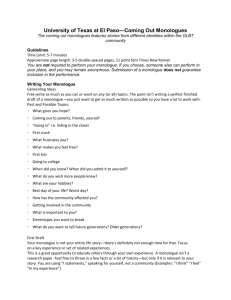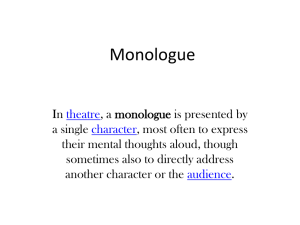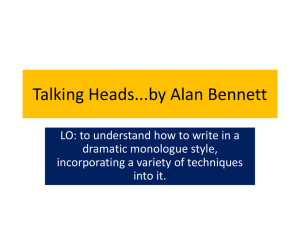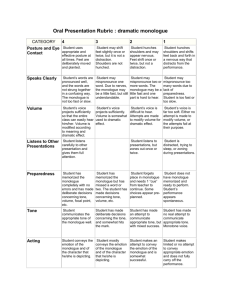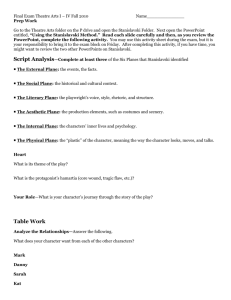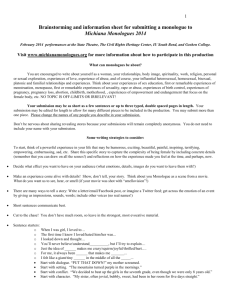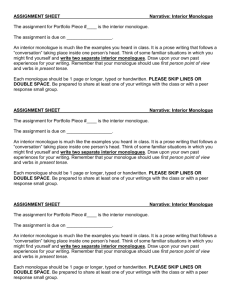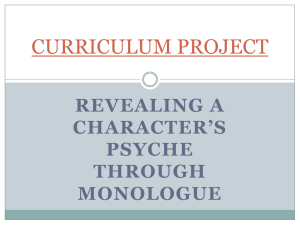Monologue
advertisement
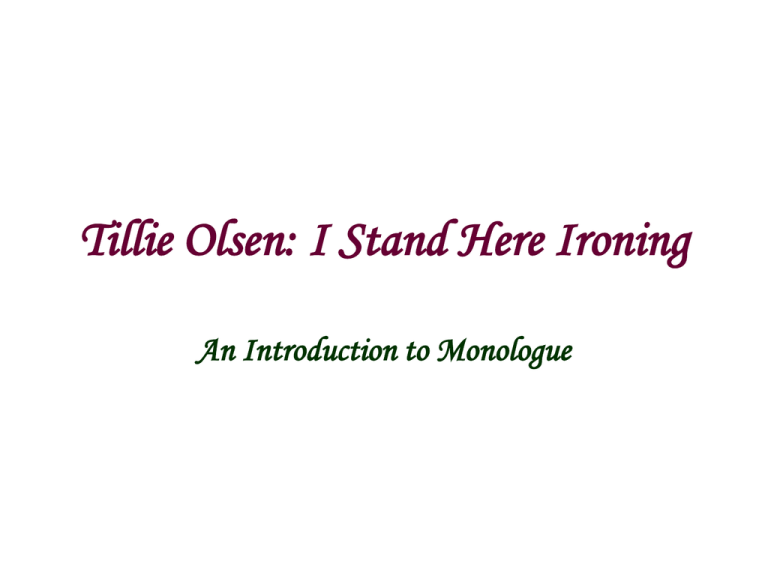
Tillie Olsen: I Stand Here Ironing An Introduction to Monologue Prologue: The Great Depression ~ Imagine you are alone in the midst of a simple, repetitive activity, such as a household chore or manual task. "What happens in your mind as you perform this chore or task?" ~Imagine the woman in the painting looked up and saw you. How does she feel about your presence (startled, angry, happy, embarrassed, etc.)? What was she thinking about before you came in? Who is she? What does she want you to know about herself? **Write for 10 minutes. (Try to keep your pen going the whole time. If you really get stuck, reread what you have written, circle something interesting and develop that idea further. ) Pablo Picasso Tillie Olsen Tillie Olsen: Homework 1. 2. 3. 4. 5. What is the year of her birth? When did she die? How old was she when she died? In what decade she was in her twenties? What was happening in the United States in the 1930's? What was life like for American families during the Great Depression? 6. Click on the picture of Olsen, which reveals a photograph of her in the 1930's when she was a young mother in her twenties. Study the photograph & answer the following questions: What difficulties and obstacles did she probably face raising a child alone during this time in history? What do you think her child's life was like? Questions for class tomorrow: ~What do you think she meant when she says she was "silenced for 20 years"? ~Why do you think she began to write after so many years of working? ~What effects did the Great Depression have on American families?" ~What factors might have contributed to families falling apart? Read: I Stand Here Ironing Study Questions 1. Spend two minutes brainstorming a list of words and phrases that come to mind when they think about the mother and Emily. Then circle those items you think are the most significant. 2. "What is the story telling us about ____________?" find support for this theme in the story Monologues ~What are the similarities in the monologues we just heard? **Monologue: a lengthy speech by a single person directed toward another, who remains silent The Five Themes of I Stand Here Ironing 1. 2. 3. 4. 5. Separation Nourishment Maternal anguish Choice Time. **In your groups, read the overview of the theme you are assigned. -Then go back to the story and locate support for the theme. Make sure you explore the whole story and underline the textual support you find. Be ready to share the textual evidence you found . Elements of a Monologue • an audience is implied • there is no dialogue • she speaker speaks through an assumed voice—a character, a fictional identity, or a persona. a monologue is one person’s speech, it is offered without overt analysis or commentary, placing emphasis on subjective qualities that are left to the audience to interpret. Tips for Writing a Good Monologue • Choose a theme • Your Character’s Voice Distinct and Consistent • Pay Attention to the Rhythm and Shape of Your Monologue • Know Your Audience, Know Your Audience, Know Your Audience! Writing Assignment: Write a Monologue Homework Assignment 1. Study each photo and choosing one to focus on. 2. Choose one family member in that photograph for whom you will write a monologue. 3. Copy questions for Monologue Guideline Sheet 4. Fill out the sheet in regard to the family member in the photo you select. 5. When you have completed the guideline sheet, write a monologue using the sheet as a guide. Monologue Assignment Tips • meet the definition of a dramatic monologue, • accurately and appropriately represent the character in a voice that seems authentic to that individual, • reflect a knowledge of the character and his/her role in the novel, and • reveal some previously unknown facet of the character’s life (i.e., the audience should gain a deeper understanding of the character’s psychology). Monologue Guideline Sheet 1. What is the approximate age and gender of the person you chose? 2. Describe the clothes he/she is wearing. (Be as descriptive as you can.) 3.Describe the facial expression of the person. (Be as descriptive as you can.) 4.What do you think this person had been doing right before this picture was taken? 5.Does this person want his/her picture taken? Why? 6.What do you think is important to him/her? 7.Who is the monologue directed toward? Families of the Great Depression Follow-up Group work 1. Share your monologues with your group. Pay attention to the differences in how each of you presented the woman. 2. Discuss for two or three minutes the differences you noticed. 3. Determine who might want to share their monologues with the class. Peer Edit Monologues ~Read the monologue of your partner. Determine whether the monologue you read contained themes. Write or Circle the themes & be prepared to share them with the class. 1. 2. 3. 4. 5. 6. Who is the “you” addressed in paragraphs 1, 3, and elsewhere in the story? Does the narrator intend to go see the person that she mentally addresses in the story? Why or why not? In what ways is the current situation part of a larger pattern of events in the life of the narrator? List the important facts of Emily’s childhood. Under what circumstances was she raised? What is the state of her physical and emotional well being? List some of the mistakes that the narrator made in raising Emily. Is she aware or unaware of these mistakes? Are there any factors in their lives that are beyond her control? What is happening in Emily’s life at the present? How has she turned out? What does this reveal about her (and maybe about young people and the human spirit in general)? Consider the symbolism of the iron and ironing board at the end of the story. How is this related to the mother’s wish for her daughter?
